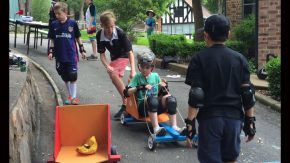A Message from The Head of Lindfield Prep
Wise questions
“We get wise by asking questions, and even if these are not answered, we get wise, for a well-packed question carries its answer on its back as a snail carries its shell.” James Stephens (Irish novelist and poet)
Questioning is a very important component of the teaching and learning process. We, as adults, ask many questions of the children in our care and naturally curious students ask us many questions too. In order to grow and learn, these questions need to be wisely constructed. Just as we can learn to improve our questioning skills, so can students. Here are some tips you may find helpful in your general interactions as a family at home.
Levels of questioning
There are several ways to categorise questions. For the sake of simplicity let’s refer to two levels, open and closed. Closed questions are those that have a right or wrong answer, that can be answered in one or a few words and that generally require little thinking. What did you have for breakfast this morning?… is a closed question.
Open questions encourage thinking and often have a multitude of answers. Often when we ask kids open questions we require them to bring their own experiences, beliefs and opinions to the topic. These types of questions can often lead to interesting discussions. Why might breakfast be the most important meal of the day?… is an open question.
There is a time and a place for asking closed questions. They are an efficient way to gain factual information. Certainly, as parents, we need to ask closed questions to our children sometimes. However, the real discussions and growth come about when we think more carefully about how we question the children in our care.
Creating thought-provoking questions
As I mentioned in an earlier article, we need to get into the habit of asking questions that we don’t already know the answer to. When we ask questions we already know the answers to, we seem to be testing kids. For example, we often see the parents of younger children asking questions like “What colour is that car?”, “How many dogs can you see in that picture?”. With questions like these we are looking for a particular response and if we don’t get that response the answer is wrong. In effect, we are drilling. In an attempt to ask questions that are more thought-provoking, try using the following question stems…
Why…?
How would it be different if…?
What are the reasons…?
Suppose that…?
What if…?
What if we knew…?
What is the purpose of…?
What would change if…?
So instead of asking “What colour is that car?” ask “How would it be different if all cars in the street were red?”
Instead of asking “How many dogs can you see in that picture?” ask “What would change if one of those dogs was actually a cat?”
See if you can use these question stems to ask thought-provoking questions while you are reading a story, or even about activities that you do together, or the places you visit and the people you know. Actually, you can probably come up with even better question stems once you get the hang of it.
Turning “What did you do today?” into an open and thought-provoking question
We’ve all asked our kids after a long day “How was your day?” and the age-old “What did you learn at school?” You are a lucky parent if your child gives you the information you are hoping to receive. Asking these sorts of questions can provoke very closed answers like “good”, “fine” and the dreaded “nothing”! If what we are looking for is a conversation about the richness of a day well-spent, then we need to create wiser questions for consideration. Here is a list that I’ve created and that I will now use with my own children. Have a look, and maybe even create your own!
What made you smile today?
Tell me something kind that you did for someone at school today?
What is the most interesting question you asked your teacher in class?
What is the funniest thing that happened to you this week?
If you could change something you did today, what would it be and why?
What happened today that you would love to happen each day?
What is the nicest thing someone said to you at school today?
What are the 3 most wonderful things about your school friends?
How would the day have been different if your teacher didn’t smile at you?
What is the purpose of your homework this week?
What if we knew that next week you had to go to a different school?
What are the reasons that you do reading (math, sport, art Etc.) at school?
If you could teach me about the most important thing you learned at school lately, what would it be?
Student-generated questions
Just as it is important for us as parents and caregivers to create wise questions, it’s also essential that students are able to ask the right questions. An important comprehension strategy in reading is actually self-questioning. If a child does not ask internal questions as they read they are less likely to be engaging with the essence of the text. We naturally ask questions and wonder about what is coming next, or how things connect when we read. Modelling the use of thought-provoking questions is in fact a great way to encourage our boys to ask their own. Here are some quick little activities you can do with kids in order to get them to ask questions.
- Reciprocal questioning using stems- Use the questioning stems above (or ones you’ve created) and take turns asking questions about each other’s day. This could be done after school or at bed-time when you are both calm and have more time.
- Reading together- Encourage your child to ask questions before, during and after reading. Write the questions on post-it notes and then see which ones are answered as you read on. Discuss the answers to each question with your child. Be mindful not to request too many, which may interrupt the flow of a story.
- Art works/pictures- Observe pictures, paintings or even artefacts that you have in your home. Write down questions that you and your children have about the art work. See if you can answer them together.
- Famous people- Choose your child’s favourite celebrity or sports person. If they could ask them anything at all, what would it be?
If your child seems to be asking closed questions. Provide some question stems and see how you can change the question to make it more thought-provoking.
Ambiguity is welcomed here
The activities and questioning techniques above are not always going to produce definite answers. There may indeed be some questions that are difficult to answer, and some that end up with no answer at all. That’s OK! What’s valuable is the discussions that arise out of asking the questions.
This week in Stage 2, teachers provided their boys with a provocation that in effect asked very difficult questions. The activity involved boys deciding where they were on a continuum of agreement with some interesting statements. This demonstrated a wide range of views on various topics and the boys were asked to provide a justification for their beliefs. Some questions they had to consider because of the statements provided were: Should everyone in Australia speak English? and Does money make you happy? Wow! There’s some thought-provoking ambiguity involved in this learning activity. You can see the Grade 3 and 4 blogs this week for more details.
Creating questions that involve ambiguity is important. It is part of developing a sense that the world is made up of an endless variety of beliefs and perspectives and that one is not necessarily better than another. If we are to truly develop boys who are internationally-minded who have a world view that will allow them to operate in such a globally connected and ever-changing atmosphere, they need to be comfortable with this ambiguity. There are plenty of current events which could spark wise (but developmentally appropriate) questions from both parents and boys. Some are sure to provide a platform for discussions and questions that even we as parents can’t confidently answer. That’s OK too!
See this link for an article about this concept of ambiguity- http://ww2.kqed.org/mindshift/2015/10/21/how-to-spark-curiosity-in-children-by-embracing-uncertainty/
Note – Creating Thought Provoking Questions Strategy extracted from:
Ritchhart, R., Church, M., & Morrison, K. (2011). Making Thinking Visible: How to Promote Engagement, Understanding, and Independence for All Learners. San Francisco, CA: Jossey-Bass.
Ben Barrington-Higgs – Head of Lindfield Prep






